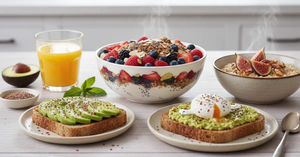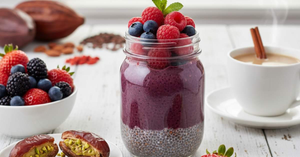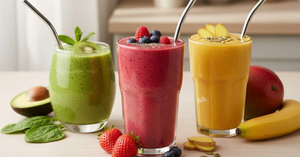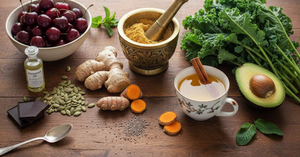“Your body is built to renew every month but protein gives that process the raw material it needs to flourish.”
The ovulatory phase marks the midpoint of your menstrual cycle, typically around Day 13–15 in a 28-day cycle. This is when a mature egg is released from the ovary, ready for fertilization.
It’s a time of peak fertility, highest estrogen levels, and naturally elevated energy and mood.
From a nutritional standpoint, this is a period of cellular activity and hormonal precision. The follicle that developed during the follicular phase is now releasing an egg, and your body requires an optimal supply of amino acids, vitamins, and minerals to support this process. That’s where protein becomes crucial.
Protein is the foundation of hormones, enzymes, and cellular repair. In the context of fertility, it plays several key roles:
A study published in the American Journal of Clinical Nutrition (2021) showed that women who consumed more plant-based protein and less refined carbohydrates had better ovulatory function and improved fertility outcomes.
For most women of reproductive age, the recommended daily protein intake is around 1.0–1.2 grams per kilogram of body weight.
For example, if you weigh 60 kg, you need around 60–70 grams of protein per day, which can easily be met with a combination of plant and animal sources.
Those who exercise regularly or are trying to conceive may benefit from slightly higher intake (up to 1.4 g/kg), as protein supports both muscle repair and hormone production.
Here are the best protein-rich foods to include during your ovulatory phase, along with their unique hormonal benefits:
Eggs are often called “nature’s multivitamin” — and rightly so.
They are rich in high-quality protein, choline, and omega-3 fatty acids, all of which support egg health and brain development in early pregnancy.
A staple in Indian diets, lentils (masoor, moong, toor dal) and chickpeas are excellent sources of plant-based protein, iron, and folate.
Rich in casein and whey proteins, Greek yogurt provides slow-digesting amino acids that support muscle and hormone repair.
Unlike most grains, quinoa is a complete protein containing all nine essential amino acids.
Paneer provides slow-release casein protein that keeps you full and supports lean tissue maintenance.
Almonds, walnuts, pumpkin, sunflower, and flaxseeds are rich in protein, omega-3 fatty acids, and vitamin E.
Chicken, turkey, and fish (like salmon or rohu) offer lean, easily digestible protein that supports egg health.
Soy provides isoflavones, natural plant estrogens that can help modulate estrogen levels, especially in women with irregular cycles.
Sprouting enhances the protein and vitamin C content of beans and lentils.
A sample one-day meal guide to ensure protein coverage across meals:
Breakfast: Vegetable omelet or moong chilla with chutney
Mid-morning: Handful of almonds and a banana
Lunch: Brown rice with dal, paneer sabzi, and salad
Evening snack: Greek yogurt with flaxseeds and fruit
Dinner: Quinoa pulao with tofu or grilled fish and sautéed vegetables
This balance keeps your blood sugar stable, hormones steady, and muscles nourished.
Protein alone cannot optimize fertility; it works synergistically with other nutrients:
Thus, a well-rounded, protein-rich diet helps maintain the delicate endocrine harmony needed for ovulation.
If your cycles are irregular, ovulation is delayed, or you have conditions like PCOS, thyroid imbalance, or low AMH, a nutritionist or gynecologist can guide you with personalized protein plans.
In some cases, protein supplements (like whey isolate or plant-based blends) can be safely included, but always under medical supervision.
Protein is not just for fitness, it’s the foundation of hormonal harmony and reproductive vitality.
During the ovulatory phase, your body is at its peak of creation, both physically and energetically. By fueling it with clean, protein-rich foods, you nurture egg quality, stabilize energy, and support emotional balance.
Think of protein as your cycle’s repair agent and silently building the tissues, enzymes, and hormones that allow your body to function with precision and grace.
About PeriodSakhi
PeriodSakhi is your trusted companion for understanding your menstrual health. With easy-to-use tools, it helps you track your periods, ovulation, fertility, moods, and symptoms, while providing insights into your overall reproductive and hormonal health. PeriodSakhi also serves as a supportive online community where women can share experiences, find reliable information, and access expert-backed guidance on menstrual health, PCOS, pregnancy, lifestyle, and more.
Disclaimer
The views, thoughts, and opinions expressed in this article/blog are solely those of the author and do not necessarily reflect the views of PeriodSakhi. Any omissions, errors, or inaccuracies are the responsibility of the author. PeriodSakhi assumes no liability or responsibility for any content presented. Always consult a qualified medical professional for specific advice related to menstrual health, fertility, pregnancy, or related conditions.
Start the conversation
No comments yet. Start the conversation by leaving the first comment!





